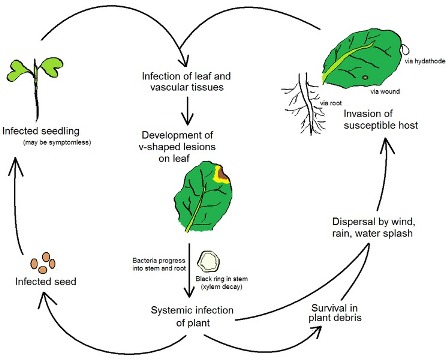"the birds and the bees"

 Xanthomonas
campestris, also known as the black rot bacterium is a
seedborne pathogen. Even though Xcc favor warm,
wet environments, it is still capable of surviving through the
winter months while remaining dormant in certain parts of host
plants in the pasture fields. When spring begins and the
new seedlings emerge, the once dormant bacterium passes from the
cotyledons and into the newly forming leaves. Once the
bacterium infects the plant internally, it attacks the xylem
tissue which then spreads the bacterium throughout the rest of
the plant. When under ideal conditions, Xcc uses
rain as a water transporter, blowing infected plant fragments
through the wind, and transport via insects and humans to
effectively spread the black rot bacterium to other hosts.
Xanthomonas
campestris, also known as the black rot bacterium is a
seedborne pathogen. Even though Xcc favor warm,
wet environments, it is still capable of surviving through the
winter months while remaining dormant in certain parts of host
plants in the pasture fields. When spring begins and the
new seedlings emerge, the once dormant bacterium passes from the
cotyledons and into the newly forming leaves. Once the
bacterium infects the plant internally, it attacks the xylem
tissue which then spreads the bacterium throughout the rest of
the plant. When under ideal conditions, Xcc uses
rain as a water transporter, blowing infected plant fragments
through the wind, and transport via insects and humans to
effectively spread the black rot bacterium to other hosts.
The main type of reproduction amongst bacteria is asexually,
chiefly by
binary fission. Binary fission is the process in which
a single bacterium replicates its own genetic material and then
continues to grow until it is able to undergo cytokinesis and
divide into two identical daughter cells. Since Xcc
is a gram-negative bacterium its walls are more flexible, then
gram-positive bacteria, allowing the simple action of pinching
inward to separate and form two daughter cells.

__________________________________________________________________________________________________
…now I know Xanthomonas campestris
sounds like such an ideal mate, but make sure to check out the
certain adaptations it partakes in
before planning anything permanent.
-- HOME -- REFERENCES -- CONTACT ME -- MULTIPLE ORGANISMS --